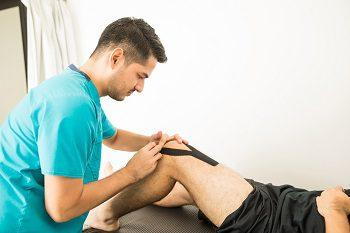Living with Restless Leg Syndrome: Tips
- posted: Oct. 09, 2023
Imagine trying to sleep, but your legs won’t stop feeling weird. They tingle, twitch, and make you want to move them all the time. That’s what life is like for people with restless leg syndrome, or RLS. If you are one of these individuals, you understand the difficulty of a restful night’s sleep.
Whether you’re dealing with RLS yourself, trying to understand a loved one’s struggle, or just curious, you’re in the right place. We’ll keep it simple and practical as we explore living with RLS with the help of some coping tips. Let’s get started on the road to better sleep.
Understanding Restless Leg Syndrome (RLS)
RLS represents a neurological disorder that induces discomfort in the legs, usually occurring during periods of inactivity or rest, such as when attempting to sleep or sit still. Patients often report these sensations as itching, tingling, crawling, or aching, and they can drive a constant urge to move the legs for relief.
However, it’s important to note that RLS can vary in severity. Some individuals may have mild symptoms that don’t significantly impact their lives. In contrast, others may struggle with more severe symptoms that disrupt their ability to sleep and carry out daily activities.
As we explore coping strategies for RLS, remember that you’re not alone in facing this condition. Many others share similar experiences, and there are ways to manage and improve your quality of life, even with RLS.

Symptoms of Restless Leg Syndrome (RLS)
- Tingling: It’s like pins and needles or an electrical feeling in your legs.
- Crawling: Some people say it feels like insects are crawling on or under their skin.
- Aching: You can expect a deep, painful sensation that causes your legs to ache.
- Restlessness: As the name implies, individuals experience a compelling urge to move their legs in search of relief.
These sensations typically occur when resting, especially when sitting or lying down. They worsen in the evening and at night, seriously disrupting your sleep.
RLS isn’t just a sleep thief; it’s a non-stop invader into every aspect of life. Approximately 5-15% of the world’s population experiences (RLS), that significantly affects their daily lives.
Common Causes of RLS
- Genetics: A family history of RLS often suggests a genetic component.
- Dopamine Imbalance: Changes in dopamine, a neurotransmitter in the brain, are linked to RLS. Dopamine helps regulate muscle movements, and an imbalance can lead to symptoms.
- Iron Deficiency: Low iron levels in the brain may play a role in RLS. Iron is essential for dopamine production, and deficiencies can trigger symptoms.
- Other Health Conditions: Certain medical conditions, such as kidney disease, diabetes, and peripheral neuropathy, can increase the risk of RLS.
- Pregnancy: Some women experience RLS, especially in the third trimester. Symptoms often improve after childbirth.
How to Know if You Have RLS?
If you believe you may have RLS, seeking consultation with a healthcare professional to receive an accurate diagnosis is crucial. He will typically consider the following criteria to diagnose RLS:
- Symptoms: You should experience the characteristic sensations in your legs and have a strong urge to move them, especially at rest.
- Timing: Symptoms are usually worse in the evening or at night and tend to be relieved by movement.
- Family History: Your risk may increase if other family members have RLS.
- Exclusion of Other Conditions: Your doctor may perform tests to rule out other conditions causing similar symptoms.
Diagnosing RLS can sometimes be tricky, so describing your symptoms accurately to your healthcare provider is crucial. Once diagnosed, numerous treatments and coping strategies are available to assist in managing and alleviating the discomfort associated with RLS.
Living with Restless Leg Syndrome (RLS): Practical Coping Strategies
If you or someone you care about is dealing with RLS, here are some practical tips for living with this condition:

- Consult a Healthcare Professional: Consulting a healthcare professional is crucial when you suspect you have RLS. This initial step is critical for finding the exact cause and ruling out other causes of your symptoms.
- Understand Your Triggers: Pay attention to what worsens or triggers your RLS symptoms. It could be certain foods, medications, or activities. Maintaining a symptom diary can help identify such patterns.
- Medication Management: Sometimes, doctors may prescribe medication to relieve RLS symptoms. Work closely with your healthcare provider to find the proper medication and dosage.
- Lifestyle Adjustments: Incorporate regular moderate exercise, such as walking or swimming, into your routine. It can effectively diminish RLS symptoms. Alongside, have a fixed and consistent sleeping schedule; sleep and wake simultaneously. Ensure your sleep space is comfortable, with a relaxed, dark, and quiet atmosphere. Consider making dietary adjustments, such as increasing your intake of iron-rich foods if you have low iron levels and reducing or eliminating caffeine and nicotine, especially in the evening.
- Stress Reduction: Embrace relaxation practices such as deep breathing, mindfulness meditation, or progressive muscle relaxation to alleviate stress and anxiety, which can exacerbate the discomfort associated with RLS. Incorporating gentle stretching or participating in yoga exercises can also contribute to leg relaxation and relieve pain.
- Temperature Therapy: Applying heat or cold packs to your legs may temporarily relieve RLS sensations.
- Compression Devices: Some individuals find relief using leg wraps or compression socks, which apply gentle pressure to the legs.
- Support Groups: Joining an RLS support group or online community can offer emotional support, a sense of community, and valuable insights from others who understand your struggle.
- Limit Medication Side Effects: If you’re taking medications for other conditions, discuss the possibility of RLS being a side effect with your doctor. Adjustments to your medication regimen may be needed.
- Stay Informed: Stay updated with the latest research and treatment options for RLS. Knowledge is a powerful tool in managing this condition.
Does Chiropractic Therapy Work for RLS?
Most RLS cases connect to some form of nervous system dysfunction. For this reason, chiropractic care can be one of the best forms of treatment for people looking for relief from restless leg syndrome. It’s crucial to approach the management of RLS with evidence-based treatments and strategies. If you’re considering chiropractic therapy for RLS, here are a few important considerations:
- Discuss with a Specialist: If you’re interested in chiropractic care, consider discussing it with a neurologist or sleep specialist with experience treating RLS. They can provide insights into whether chiropractic therapy may be a suitable adjunct therapy for your case.
- Safety Concerns: Prioritize safety; always make safety a top priority. If you pursue chiropractic care, choose a licensed and experienced chiropractor familiar with RLS and its potential interactions with musculoskeletal health.
Chiropractors may use various therapies to address musculoskeletal issues, which can sometimes be associated with RLS-like symptoms but are not a direct treatment for RLS. These therapies may include:
- Spinal Manipulation: Chiropractors often use manual techniques to adjust the spine to improve spinal alignment and relieve musculoskeletal pain. It may benefit individuals who experience discomfort in the back or legs that is secondary to RLS.
- Stretching and Exercise: Chiropractors may recommend specific exercises to improve flexibility, strengthen muscles, and alleviate musculoskeletal discomfort. These exercises may indirectly help with some RLS symptoms.
- Massage Therapy: Massage techniques used by chiropractors can help relax muscles and reduce tension, which may benefit individuals experiencing muscle cramps or discomfort associated with RLS.
While some people may find relief through complementary therapies like chiropractic care, it’s essential to approach RLS management comprehensively and prioritize treatments with established efficacy. Always consult your healthcare professional before availing of the chiropractic services.
Concluding Thoughts
Managing RLS is a uniquely individual journey; what proves effective for one person may not yield the same results for another. Discovering the optimal combination of strategies tailored to your specific needs may require some patience, as well as a process of trial and error. Practice self-patience and don’t hesitate to seek professional assistance when necessary. Living with RLS is challenging, but with the proper support and strategies, you can improve your quality of life and find relief from its symptoms.
Contact your Scottsdale Chiropractor, Dr. Abbas Khayami, D.C., at Better Health Solutions to learn more about how to live with Restless Leg Syndrome.
Resource:
Restless Leg Syndrome and Chiropractic Care
*This media/content or any other on this website does not prescribe, recommend, or prevent any treatment or procedure. Therefore, we highly recommend that you get the advice of a qualified dentist or other medical practitioners regarding your specific dental condition.*
Better Health Solutions
8040 E Indian School Rd Suite 100,
Scottsdale, AZ 85251
Monday
8:30 am - 6:00 pm
Tuesday
8:30 am - 6:00 pm
Wednesday
8:30 am - 6:00 pm
Thursday
8:30 am - 6:00 pm
Friday
8:30 am - 6:00 pm
Saturday
8:30 am - 2:30 pm
Sunday
Closed
